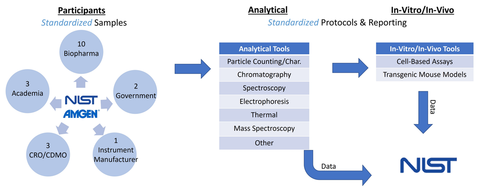Summary
The National Institute of Standards and Technology (NIST), in collaboration with the American Association of Pharmaceutical Scientists (AAPS), is coordinating an interlaboratory study to examine the relationship between aggregated or stressed protein-based biotherapeutics and unwanted immune responses.
Description

A schematic overview showing the distribution of the standardized samples to study participants, the use of standardized protocols for measurements, and standardized reporting of data back to NIST for analysis.
To ensure the safety and efficacy of protein-based biotherapeutics, manufacturers strive to avoid unwanted immune responses caused by the biotherapeutic. Protein immunogenicity is a complex topic and depends on multiple factors related to the product, patient profile, and treatment.1,2 Furthermore, there is a large gap in our understanding of product related attributes (aggregates, particles, chemical modification, protein conformation, sequence, etc.) and their influence on biological responses.3,4,5
Historically studies of the immune responses caused by aggregated proteinaceous particle have reached inconsistent conclusions, likely due to the use of different proprietary molecules with different immunomodulatory activity, different formulation conditions, non-standardized reporting of immunogenicity data, differences in administration routes, and many other factors.3 Having one lab generate all the stressed material with the same molecule(s) and employing consensus-driven analytical, in-vitro, and in-vivo protocols for acquisition and reporting of data will alleviate some of these challenges, enabling a more impartial discussion in the field.
This interlaboratory study is an effort to examine if correlations exist between protein aggregates/stressed protein and elevated in-vitro/in-vivo responses. This study will help to 1) identify critical quality attributes of stressed proteins that may lead to an increase in biological activity in in-vitro/and or in-vivo model systems; 2) examine variabilities of the characterization assays, in-vitro, and in-vivo models; 3) determine if in-vitro results can be correlated to in-vivo results; and 4) reconcile the findings with those in literature. This study will deepen the current knowledge of specific aggregate characteristic(s) and its potential effect on immunogenicity.
Study Design
The study consists of three phases: analytical, in-vitro, and in-vivo phases. The participants are from industry, academia, government, contract research organizations (CRO), and instrument manufacturers.
In the first phase, eighteen participants will characterize two stressed/aggregated monoclonal antibodies (IgG1 and IgG2), both donated from two of the labs. One lab will generate all of the stressed material using the two mAbs; each mAb will be subjected to two stress conditions. The participants will employ analytical assays (particle counting/characterization, chromatography, mass spectroscopy, electrophoresis, spectroscopy, and thermal unfolding) to characterize the stressed samples. Participants will follow and report data according to consensus-driven guidelines proposed by the group.
In the second and third phase, participants will use the samples generated in phase 1 for in-vitro and in-vivo model systems, such as cell-based or mouse models, respectively. Participants will use company-specific procedures to perform these assays but will also comply with the guidelines on collecting and reporting immunogenicity data, as defined by the group.
The overarching goals of the AAPS Interlaboratory Study are to identify whether protein aggregates or characteristics of stressed protein biotherapeutics are responsible for eliciting in-vitro and/or in-vivo activity.
| Phase 1: Generate stressed samples, distribute to participants for analytical characterization | ⇨ | Goal #1: Examine analytical variability while controlling aggregate generation and analytical characterization (i.e. mAbs are stressed in 1 lab, by similar stress, and analyzed using consensus based protocols); reconcile discrepancies in literature |
|---|---|---|
| Phase 2: Perform in-vitro assays with stressed samples | ⇨ | Goal #2: Examine stressed samples (generated in #1) in in-vitro model systems; assess variability of results and correlate results from #1 with #2 (if any); reconcile discrepancies in literature |
| Phase 3: Perform in-vivo assays with stressed samples | ⇨ | Goal #3: Examine stressed samples (generated in #1) in in-vivo model systems; assess variability of results and correlate with in-vitro results and with analytical results; reconcile discrepancies in literature |
A Message for Participants
Participants are requested to review the study instructions and use the protocols provided for the analytical method(s) to acquire data. Accompanying data reporting templates are to be used to record instrument parameters and fully analyzed data. Completed data reporting templates should be sent to aapsinterlab [at] nist.gov (aapsinterlab[at]nist[dot]gov).
Study Instructions: AAPS Interlaboratory Study Instructions Updated with Comments 10/4/2023.
| Tier 1: Highest priority methods | Protocol | Data Reporting Template |
|---|---|---|
| Visual Inspection | VI_Protocol | VI_DATA |
| Dynamic Light Scattering | DLS_Protocol | DLS_DATA |
| Light Obscuration | LO_Protocol | LO_DATA |
| Flow Imaging | FI_Protocol | FI_DATA |
| SEC/SEC-MALS | SECMALS_Protocol | SECMALS_DATA |
| NTA | NTA_Protocol | NTA_DATA |
| UV-Vis | UVVis_Protocol | UVVis_DATA |
| Near UV CD | nUVCD_Protocol | nUVCD_DATA |
| FTIR | FTIR_Protocol | FTIR_DATA |
| rCE-SDS and/or nrCE-SDS | CE-SDS_Protocol_ | CE-SDS_DATA |
| Tier 2: Sizing/Characterization | Protocol | Data Reporting Template |
|---|---|---|
| AF4 | AF4_Protocol | AF4_DATA |
| Intrinsic Fluorescence | IF_Protocol_ | IF_DATA |
| Extrinsic Fluorescence | EF_Protocol | EF_DATA |
| Resonant Mass Measurement | RMM_Protocol | RMM_DATA |
| SV-AUC | SV_AUC_Protocol | SV_AUC_DATA |
| DSC | DSC_Protocol | DSC_DATA |
| DSF | DSF_Protocol | DSF_DATA |
main contacts
Srivalli Telikepalli (NIST)- primary contact
Email: srivalli.telikepalli [at] nist.gov (srivalli[dot]telikepalli[at]nist[dot]gov) or aapsinterlab [at] nist.gov (aapsinterlab[at]nist[dot]gov)
Phone: (301) 975-3398
Dean Ripple (NIST)
Email: dean.ripple [at] nist.gov (dean[dot]ripple[at]nist[dot]gov)
Marisa Joubert (Amgen)
Email: mjoubert [at] amgen.com (mjoubert[at]amgen[dot]com)
Joshua Tokuda (Amgen)
Email: jtokuda [at] amgen.com (jtokuda[at]amgen[dot]com)
Kimya Nourbakhsh (Amgen)
Email: knourbak [at] amgen.com (knourbak[at]amgen[dot]com)
Linda Narhi
Email: lindaonarhi [at] gmail.com (lindaonarhi[at]gmail[dot]com)

